Advertisements
Advertisements
प्रश्न
Three light rays red (R), green (G) and blue (B) are incident on a right angled prism ‘abc’ at face ‘ab’. The refractive indices of the material of the prism for red, green and blue wavelengths are 1.39, 1.44 and 1.47 respectively. Out of the three which colour ray will emerge out of face ‘ac’? Justify your answer. Trace the path of these rays after passing through face ‘ab’.
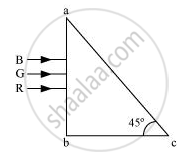
उत्तर

The blue ray will emerge out of the face ‘ac’.
The three light rays will go through ‘ab’ as the three are perpendicular to ‘ab’. However, when they will hit ‘ac’, they will refract with an angle of incidence of 45°.
Refractive indices for three light rays are given.
Red (R) = 1.39
Green (G) = 1.44
Blue (B) = 1.47
Total internal reflection takes place if the angle of incidence is such that
`sin r>I`
The refractive indices are from air to prism. To convert them from prism to air, we take their reciprocal.
`R = 1/(1.39) = mu_1`
`G = 1/(1.44) =mu_2`
`B1/(1.47) =mu_3`
For red:
`(sini)/(sinr) =mu`
`(sin45)/mu_1 = sinr`
sin r = 0.9828, which is less than 1
Thus, red light will pass through the face ‘ac’.
Similarly, for green:
`sinr = (sin45)/mu_2`
`1.01`
This is greater than 1. Therefore, it will not pass through, but reflect back in the same medium.
For blue:
`sinr = (sin45)/mu_3`
`= 1.039`
Even this will reflect back because of total internal reflection.
APPEARS IN
संबंधित प्रश्न
A ray of light, incident on an equilateral prism `(μ_g = sqrt3)`moves parallel to the base line of the prism inside it. Find the angle of incidence for this ray.
Trace the path of the ray (P) of light passing through the glass prism as shown in the figure. The prism is made of glass with critical angle ic = 41°.
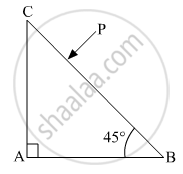
Can you ever have a situation in which a light ray goes undeviated through a prism?
The refractive index of a prism whose angle A = 60° is `sqrt2`. Then the angle of minimum deviation δm will be ______.
For a glass prism `(µ = sqrt(3))` the angle of minimum deviation is equal to the angle of the prism. Find the angle of the prism.
A ray PQ is incident normally on the face AB of a triangular prism of refracting angle 60° as shown in figure. The prism is made of a transparent material of refractive index `2/sqrt(3)`. Trace the path of the ray as it passes through the prism. Calculate the angle of emergence and the angle of deviation.
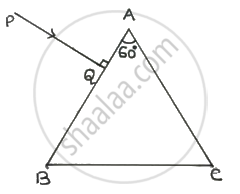
A horizontal ray of light passes through a prism of index 1.50 and apex angle 4° and then strikes a vertical mirror, as shown in the figure (a). Through what angle must the mirror be rotated if after reflection the ray is to be horizontal?
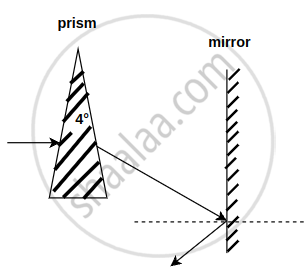
A ray of light when incident upon a thin prism suffers a minimum deviation of 39°. If the shaded half portion of the prism is removed, then the same ray will ______.
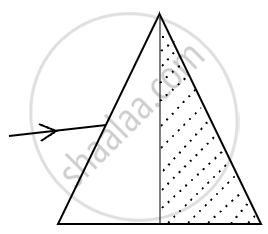
Two concave refracting surfaces of equal radii of curvature face each other in the air as shown in the figure. The point object O is placed midway between the centre and one of the poles. Then the separation between the images of O formed by each refracting surface is ______.
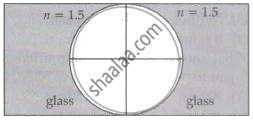
A ray of light is refracted by a glass prism. Obtain an expression for the refractive index of the glass in terms of the angle of prism A and the angle of minimum deviation δm.
